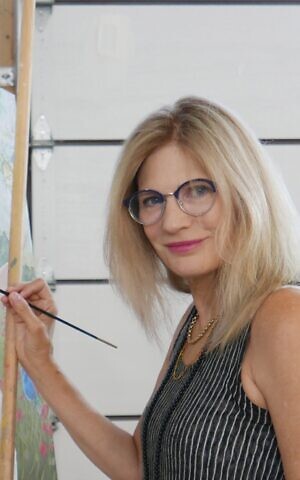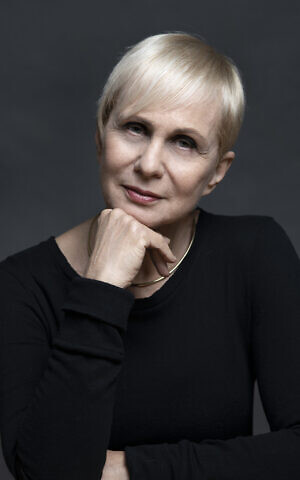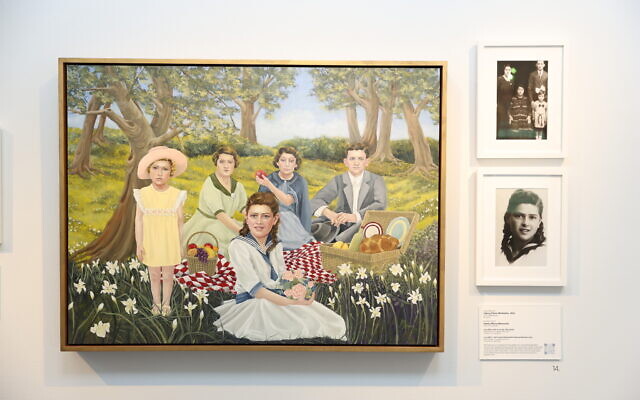WALTHAM, Massachusetts — In an ostensibly everyday photo of three young women cuddling a dog, one thing that stands out is the haunting look on the faces of Tema Schneiderman and her two friends. That’s because the trio served as partisans in Lithuania and Poland during World War II. Tragically, Schneiderman was captured in the Warsaw Ghetto in January 1943 and killed by Nazis at Treblinka. She was just 26.
Schneiderman is among a group of young Jewish women and girls who were victims of the Holocaust and are receiving a unique tribute — a multimedia exhibit, “Lives Eliminated, Dreams Illuminated,” or “LEDI,” on display at the Hadassah-Brandeis Institute at Brandeis University through October 25. A collaboration between US-based artist Lauren Bergman and Israeli composer Ella Milch-Sheriff, the exhibit incorporates art, music and historical images. It debuted at the school’s Kniznick Gallery in September. Future stops are scheduled for the Jewish Museum of Florida in Miami and the Memory and Tolerance Museum Mexico City.
Tragically, midway through the exhibition’s stay at Brandeis, real-time terror erupted in Israel. On October 7, Hamas launched a brutal onslaught when 2,500 terrorists swarmed into Israel under the cover of a barrage of rocket fire, killing, burning, and torturing 1,400 Israelis — mostly civilians — and taking an estimated 220 hostages. A building across from Milch-Sheriff’s home in Tel Aviv took a direct hit from a Hamas rocket.
The victims included many women and girls, such as 21-year-old French Israeli Mia Schem, captured during the bloody massacre at the Supernova rave near Kibbutz Re’im. Employing psychological warfare, Hamas has released a video of Schem in captivity.
“LEDI is happening today,” Milch-Sheriff reflected. “It is not a piece of history, not a piece of what had happened 70 or 80 years ago. It happens now. It happened just [nine] days ago, and it happened in the Jewish state.”
Get The Times of Israel’s Daily Edition
by email and never miss our top stories
By signing up, you agree to the terms
In follow-up interviews in the aftermath of the attacks, both Milch-Sheriff and Bergman told The Times of Israel that the exhibit has heightened relevance today.
Tema Schneiderman, right, with fellow partisan members in an undated photo taken prior to her capture by the Nazis in January 1943. (Courtesy of the Dr. David M. Milch Foundation)
Consisting of 23 paintings paired with musical compositions, the project originated with an archival photo of a young girl slain in the Holocaust that Bergman saw online about five years ago. At the time, she was concerned about contemporary events such as the 2017 Unite the Right white supremacist riots in Charlottesville, Virginia, and the 2018 mass shooting at the Tree of Life synagogue in Pittsburgh.
“I did a little sketch in which I wanted to give this little girl a happier world,” Bergman told The Times of Israel, “for the world to remember her… there was a life that never got to unfold.”
“My whole artistic career is about the female narrative,” she said. “Social issues or just life through the female lens. Basically, that’s how I experience the world, that’s how I see the world, very much through being a woman.”
And, she added, “I think women experienced the Holocaust differently, horrifically… I’m not saying it’s like a competition over who suffered more. It’s just a different viewpoint.”
From real-life images of female victims, Bergman created paintings that envisioned alternate futures for their subjects, incorporating bright colors and a variety of toys and animals.

Artist Lauren Bergman. (Courtesy of Bergman)
As the artist explains, in her painting of Schneiderman, the pet dog becomes a wolf, an animal that symbolizes toughness and strength in numbers, traits shared by the partisans. Schneiderman’s toughness is further conveyed by the motorcycle boots Bergman depicts her wearing.
Some of the historical images were sent to Bergman through victims’ family members. Others she found in archives such as Yad Vashem.
For the latter, it was all but impossible to reach out to surviving family members to let them know about the project.
“You know, it’s a great question,” Bergman said. “I have no idea how to go about doing that… We’d love for someone to try.” She added, “In a lot of archives… there’s no information where the photograph originated. Yad Vashem has the people who sent them in, but no contact information or anything.”
Milch-Sheriff composed pieces for each woman and girl, often weaving in relevant music from a subject’s background — in Schneiderman’s case, “Zog nit keyn mol” (“Never Say”), the song associated with the Warsaw Ghetto partisans. Raised by Holocaust-survivor parents, Milch-Sheriff remembered her father singing the song to her as a child. He lost his first wife and their three-year-old son in the Shoah.
Bergman noted two especially disturbing victims’ narratives in the exhibit — two young women whose identities remain unknown and whose stories are represented across from each other in the gallery space.

Composer Ella Milch-Sheriff. (Courtesy of Daniel Sheriff)
“She Dreams of Flowers” is Bergman’s first painting in the series. It imagines a better fate for a woman shown in a still from an undated 8 mm film found by American troops in an SS barracks. A nude woman sits on a curb in the then-Polish city of Lwόw, surrounded by a crowd whose members are shown waist-down. An anonymous hand reaches out to touch the woman’s head.
In Bergman’s painting, the woman reposes in a peaceful meadow, accompanied by a bobcat. Milch-Sheriff’s composition featured a melody akin to an American march, which grew progressively louder in the piece, representing the US soldiers who discovered the film footage.
Across the floor, “Sunflowers and Butterflies” addresses an equally harrowing narrative — a woman shown in a 1941 photo, her face bleeding, her body half-clothed, fleeing a mob, including a boy wielding a stick.
“It’s just the most horrifying experience that humanity can get in terms of depravity,” Bergman says in the audio interviews with her and Milch-Sheriff that accompany the exhibit. “Photographed by a bystander, beaten by a child, chased by people in your community… This is all that’s left of this woman’s life.”
Bergman created a painting in which the woman dashes through a field of sunflowers, poppies and butterflies. Milch-Sheriff developed a composition in which the woman’s flight is conveyed through percussion and woodwind instruments.
Of the women in both narratives, Bergman said, “These were women who had their clothes stripped from them and were chased and beaten in the streets by mobs of civilians. I look at the footage of what happened to girls at that [Supernova] music festival and… there’s such a direct parallel.”
Referencing the partisan Schneiderman, Milch-Sheriff said that in Israel today, there are “stories of young woman soldiers, like 18, 19 years old, that were so brave and saved the lives of so many [in the October 7 onslaught]. Some of them were killed, some of them survived to tell.” Comparing them with Schneiderman, the composer said, “They were like the same.”

In this painting by artist Lauren Bergman on display in the exhibit ‘Lives Eliminated, Dreams Illuminated,’ Holocaust survivor Lusia Rosenzweig Milch has a family picnic on Rosh Hashanah. (Courtesy of the Dr. David M. Milch Foundation)
Most of the subjects of the exhibit perished in the Holocaust. Yet there is one known survivor — Lusia Rosenzweig Milch, now in her 90s, the mother of Dr. David M. Milch, whose namesake Dr. David M. Milch Foundation has spearheaded the exhibit. Eight years old when the war began, she was the lone member of her immediate family to escape and lost over 100 extended family members. In Bergman’s painting, she gets to have a family picnic on Rosh Hashanah, while Milch-Sheriff’s paean to her aunt brings in a Yiddish song, “Rozhinkes Mit Mandlen” or “Raisins with Almonds.”
“I could not imagine coming from a large, loving, well-to-do family, celebrating together, sharing life together, to be the one to survive, to move forward in life,” Bergman said in her audio interview. Citing the painting, she added, “Her family is standing behind her. They will stand by her eternally … as we carry all our ancestors forward.










